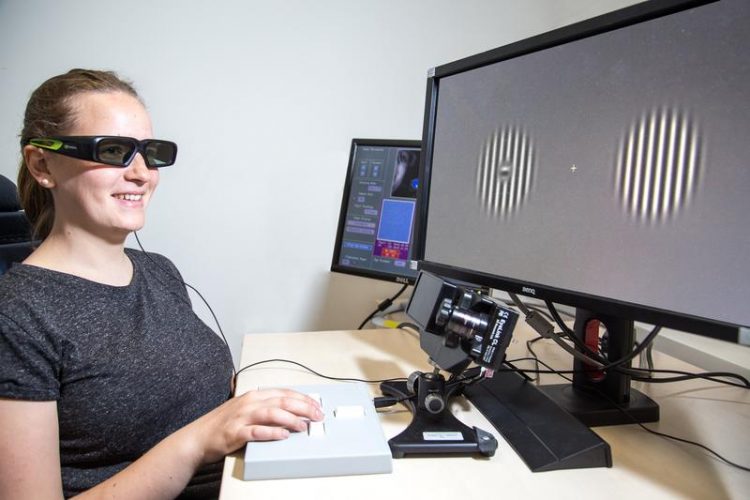Humans rely more on their subjective perception than on the reality – Surprising results

Our brain fills in the gaps in our percepts – and as a result we treat the filled-in percepts as more reliable than reality itself. Copyright: Osnabrueck Universitity/ Ricardo Gameiro
It is a well-established fact that our percepts do not always reflect reality. However, it seems that we don’t just accept this unconsciously, but, surprisingly, we even seem to prioritize the filled-in percept to the reliable input. This finding surprised even the scientists who carried out this study using the phenomenon of the blind spot of the eye.
The study from the Osnabrueck University, Germany, reveals that when choosing between two identical visual objects – one generated internally based on information from the blind spot and an external one – we are surprisingly likely to show a bias towards the internal information.
»To make sense of the world around us, we must combine information from multiple sources while taking into account how reliable they are«, says senior author Professor Peter König, from the Institute of Cognitive Science. »When crossing the street, for example, we usually rely more on input from our eyes than our ears. However we can reassess our reliability estimate: on a foggy day with poor visibility, we might prioritize listening for traffic instead. Our brain makes an assessment of the reliability of our percepts. «
But how does our brain deal with incomplete percepts? This is where the blind spot comes into play: We are able to see because the light coming from the outside world arrives at the light-sensitive photoreceptor cells of the retina. However, there is an area on the retina where the presence of the optic nerve leaves no space for light-sensitive receptors and thus we do not receive any visual input from the outside world. This region is called the ‘blind spot’.
“In the case of the blind spot, the brain ‘fills in’ the missing information from its surrounding, resulting in no apparent difference in what we see,” explains Professor Peter König. “While this fill-in is normally accurate enough for the daily routine, it is mostly unreliable because no actual information from the real world ever reaches the brain«, says the cognitive scientist. »However, it had been unclear whether we are aware of the unreliability of these percepts.«
To find out, around 100 study participants compared two striped stimuli, which were physically different but perceived as identical due to the blind spot. The task was to select the image they thought to represent the continuous stimulus.
»We thought people would either make their choice without preference – not being aware of the blind spot – or with a preference towards the real, continuously striped stimuli, « says first author Benedikt Ehinger, researcher at the Osnabrück University. In reality, exactly the opposite happened: »The participants chose the blind spot stimulus more often than the fully perceived one. This was very surprising. «
So, why are subjects so keen on the blind-spot information when it is essentially the least reliable? The team’s interpretation is that subjects compare the target, the continuous stimulus, against the incoming sensory input resulting in an error signal which represents the mismatch. In the absence of veridical information, no deviation and thus no error or a smaller signal occurs. Ultimately it leads to a higher credibility at the decision making stage. This indicates that perceptual decision-making can rely more on inferred rather than real information, even when there is some knowledge about the reduced reliability of the inferred image available in the brain.
“In other words, the implicit knowledge that a filled-in stimulus is less reliable than an external one does not seem to be taken into account for perceptual decision-making,” Ehinger explains.The team says that understanding how we integrate information from different sources with different reliabilities can inform us about the exact mechanisms used by the brain to make decisions based on our percepts.
Thus, new questions arise: Is the tendency to favor information generated within the brain unique to the visual blind spot, or does it also occur elsewhere? Which are the mechanisms of the brain to decide about the trustworthy of the various percept sources?
Nevertheless, »There is no reason to fear the blind spot – it won’t lead you astray in everyday situations – especially with both eyes open.« says Professor König. »However, we should keep it in mind and investigate that we tend to put subjective perception before reality. «
Further information for the media:
Prof. Dr. Peter Koenig, Osnabrueck University,
Institute of Cognitive Science,
Department of Neurobiopsychology,
Wachsbleiche 27, 49090 Osnabrück,
Tel: +49 541 969 2399 Fax: +49 541 969 2596,
E-Mail: peter.koenig@uni-osnabrueck.de
Benedikt Ehinger, Osnabrueck University,
Institute of Cognitive Science,
Department of Neurobiopsychology,
Wachsbleiche 27, 49090 Osnabrueck,
Tel: +49 541 969 2245 Fax: +49 541 969 2596,
E-Mail: behinger@uni-osnabrueck.de
Media Contact
More Information:
http://www.uni-osnabrueck.deAll latest news from the category: Information Technology
Here you can find a summary of innovations in the fields of information and data processing and up-to-date developments on IT equipment and hardware.
This area covers topics such as IT services, IT architectures, IT management and telecommunications.
Newest articles

Properties of new materials for microchips
… can now be measured well. Reseachers of Delft University of Technology demonstrated measuring performance properties of ultrathin silicon membranes. Making ever smaller and more powerful chips requires new ultrathin…

Floating solar’s potential
… to support sustainable development by addressing climate, water, and energy goals holistically. A new study published this week in Nature Energy raises the potential for floating solar photovoltaics (FPV)…

Skyrmions move at record speeds
… a step towards the computing of the future. An international research team led by scientists from the CNRS1 has discovered that the magnetic nanobubbles2 known as skyrmions can be…





















